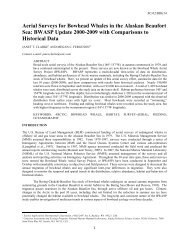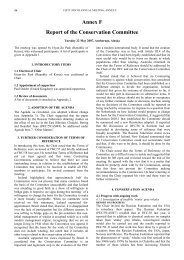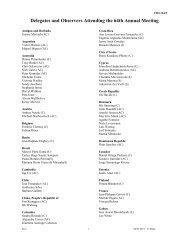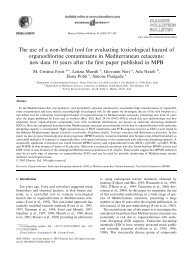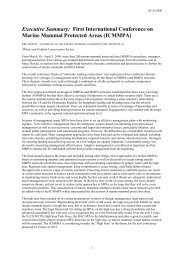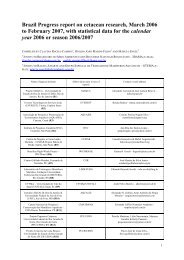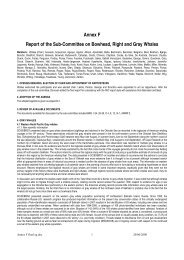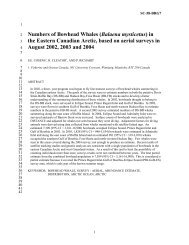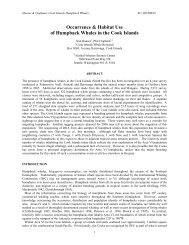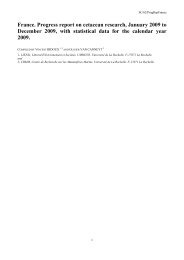Recording Cuvier's beaked whales (Ziphius cavirostris) with a ...
Recording Cuvier's beaked whales (Ziphius cavirostris) with a ...
Recording Cuvier's beaked whales (Ziphius cavirostris) with a ...
You also want an ePaper? Increase the reach of your titles
YUMPU automatically turns print PDFs into web optimized ePapers that Google loves.
Pavan & al. - 1 - SC/58/E18<strong>Recording</strong> Cuvier’s <strong>beaked</strong> <strong>whales</strong> (<strong>Ziphius</strong> <strong>cavirostris</strong>) <strong>with</strong> awideband towed array.Pavan G., Fossati C., Priano M. , Manghi, M.Università di Pavia, Centro Interdisciplinare di Bioacustica e Ricerche Ambientali,Via Taramelli 24, 27100 Pavia, Italy. http://www.unipv.it/cibraEmail gpavan@cibra.unipv.itABSTRACTIn September 2005 CIBRA participated to a wide research campaign organized in the Ligurian Sea by NURC (NATOUndersea Research Center) to study Cuvier’s <strong>beaked</strong> <strong>whales</strong>, characterize their habitat, and possibly remotely recordtheir acoustic signals. The CIBRA team, onboard the Krill, a 12 meters long catamaran, surveyed the area off theWestern Ligurian coast <strong>with</strong> an advanced Passive Acoustic Monitoring (PAM) equipment based on a high qualitytowed array connected to a wideband low-noise front-end to allow digital recording <strong>with</strong> nearly 90 kHz bandwidth. OnSeptember 25 th , a few minutes after two sighted animals started their dive, high frequencies clicks <strong>with</strong> featuresmatching the description based on WHOI’s D-TAG (Johnson et al. 2005, Zimmer et al. 2005) were recorded.This was the first recording of <strong>Ziphius</strong> <strong>cavirostris</strong> clicks ever made <strong>with</strong> a sub-surface towed array that exactly matchD-TAG data. The result is relevant for setting up affordable and easy to use equipment to be used for mitigationoperations in areas where the presence of Cuvier’s <strong>beaked</strong> <strong>whales</strong> must be estimated and monitored.INTRODUCTIONThe ability to detect marine mammals in a specific area is a fundamental requirement for the correct implementation ofmitigation procedures aimed at reducing the impact of high power acoustic sources during either civil and militaryoperations. Passive acoustic monitoring is one of the tools to be used for this task, but animals, to be detectable, mustemit acoustic signals whose time-frequency structure and repetition rate are known and detectable <strong>with</strong> the usedequipment. Cuvier’s <strong>beaked</strong> whale, a critical species when sonar operations are concerned, is difficult to detect; itsacoustic features have been discovered recently by using sophisticated digital recording tags, but sub-surface detectiondevices have never been proven reliable till now.METHODSIn late September 2005 CIBRA was in charge of the bioacoustic part of a wide NURC (NATO Undersea ResearchCenter) research campaign (Zifio ’05) in the Ligurian Sea to study Cuvier’s <strong>beaked</strong> <strong>whales</strong>, characterize their habitat,and possibly remotely record their acoustic signals. Up to five different platforms worked at the same time, <strong>with</strong>different tasks. CIBRA team was onboard the Krill, a 12 meters long catamaran, <strong>with</strong> the CIBRA PAM equipmentbased on a high quality towed array, now improved <strong>with</strong> a wideband low-noise front-end to allow digital recording <strong>with</strong>nearly 90 kHz bandwidth (192 kHz sampling rate).RESULTSOn September 25 th , the Krill quietly approached the location where three Cuvier’s <strong>beaked</strong> <strong>whales</strong> were sighted byanother vessel. Close to the location of the last sighting, the team saw the blows of two animals, immediately beforetheir dive. No other animals of any species were observed before and after this sighting. The catamaran was stopped,the engines turned off and the array sank to more than 40 meters but not in a vertical orientation due to strong driftingconditions. A few minutes after the animals started their dive, high frequencies click trains on the real-time spectrogramdisplay were noticed (SeaProUltra, two channels, 96 kHz bandwidth). Later analyses on the recorded files showed clickseries <strong>with</strong> features matching the description given by recent literature based on D-TAG recording (Johnson et al. 2005,Zimmer et al. 2005), but never matched the description given by Frantzis (2002). Recorded clicks show energy between16 and 60 kHz, <strong>with</strong> a spectrum centered on 40 kHz; click duration about 300 µs; average ICI 380 ms (range 370-415).Frequency center, bandwidth, waveform, repetition intervals and amplitude variations related <strong>with</strong> head scanningmovements indicate that the recording captured the emissions of two <strong>Ziphius</strong> <strong>cavirostris</strong>.Worthy to note that the amplitude of the clicks is not constant but oscillating, as it could be expected by a directionalsource swimming and scanning the environment <strong>with</strong> left-right movements of the head. In such a case, the hydrophonesget the maximum amplitude only when in the beam axis.CONCLUSIONThis result proves feasible the development of a passive acoustic detection system to be used for mitigation operationsin areas where the presence of Cuvier’s <strong>beaked</strong> <strong>whales</strong> must be estimated an monitored. To increase detectionprobability, other than improving bandwidth and sensitivity, along <strong>with</strong> lowering self-noise, it is required to tow thehydrophones as deep as possible. According to D-TAG data, Cuvier’s <strong>beaked</strong> <strong>whales</strong> do vocalize at great depth, at highfrequency and <strong>with</strong> a narrow emission beam. Only little energy spreads toward the sea surface and this is why so manyattempts to record these animals were unsuccessful in the past.
Pavan & al. - 2 - SC/58/E18ACKNOWLEDGEMENTSThis cruise was carried out <strong>with</strong>in the NURC (NATO Undersea Research Center) SOLMAR project. We acknowledgeNURC for organizing and funding the operations, ONR for having funded the development of the equipment, andCETUS for having hosted us on the katamaran.REFERENCESFrantzis A., Goold J.C., Skarsoulis E.K., Taroudakis M.I., Kandia V., 2002. Clicks from Cuvier’s <strong>beaked</strong> <strong>whales</strong>,<strong>Ziphius</strong> <strong>cavirostris</strong> (L). J. Acoust. Soc. Am., Vol. 112, No. 1: 34-37.Johnson M., Peter T. Madsen P.T., Zimmer W.M.X., Aguilar de Soto N., Tyack P., 2004. Beaked <strong>whales</strong> echolocate onprey. Proc. R. Soc. Lond. B (Suppl.) 271: S383–S386.Zimmer W.M.X., Johnson M., Madsen P.T., Tyack P., 2005. Echolocation clicks of free-ranging Cuvier’s <strong>beaked</strong><strong>whales</strong> (<strong>Ziphius</strong> <strong>cavirostris</strong>). J. Acoust. Soc. Am. 117 (6): 3919-3927.CIBRA website http://www.unipv.it/cibraCETUS website http://www.cetusresearch.orgNURC website http://www.nurc.nato.intSOLMAR website http://solmar.nurc.nato.intFig. 1 – Map of the detection location (Ligurian Sea, Italy).Fig. 2 – Waveform of a click received on the two hydrophones of the towed array. X-tic 500 µs.
Pavan & al. - 3 - SC/58/E18Fig. 3 – Spectrogram of a click and its echo.Fig. 4 - A 30 seconds spectrogram of the detection. The horizontal lines are due to electric interferences. Worthy to notethat the amplitude of the clicks is not constant but oscillating, as it could be expected by a directional source swimmingand scanning the environment <strong>with</strong> left-right movements of the head. The two loudest clicks were probably recordedwhen the hydrophone was in beam axis.



